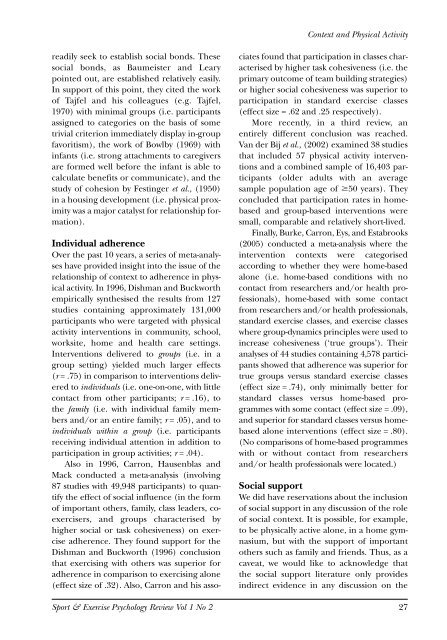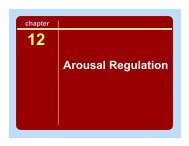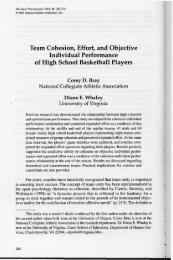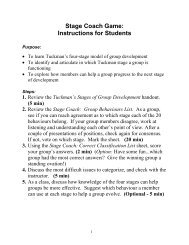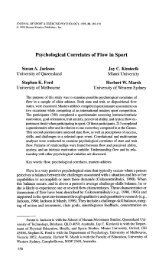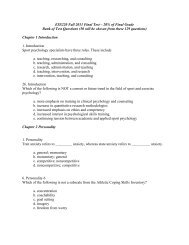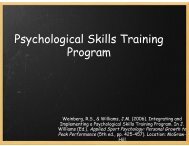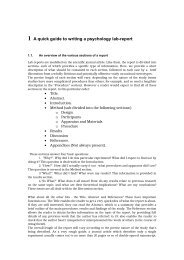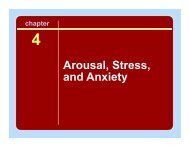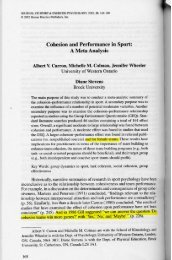Sport and Exercise Psychology Review - Sport Psychology Goes to ...
Sport and Exercise Psychology Review - Sport Psychology Goes to ...
Sport and Exercise Psychology Review - Sport Psychology Goes to ...
You also want an ePaper? Increase the reach of your titles
YUMPU automatically turns print PDFs into web optimized ePapers that Google loves.
Context <strong>and</strong> Physical Activity<br />
readily seek <strong>to</strong> establish social bonds. These<br />
social bonds, as Baumeister <strong>and</strong> Leary<br />
pointed out, are established relatively easily.<br />
In support of this point, they cited the work<br />
of Tajfel <strong>and</strong> his colleagues (e.g. Tajfel,<br />
1970) with minimal groups (i.e. participants<br />
assigned <strong>to</strong> categories on the basis of some<br />
trivial criterion immediately display in-group<br />
favoritism), the work of Bowlby (1969) with<br />
infants (i.e. strong attachments <strong>to</strong> caregivers<br />
are formed well before the infant is able <strong>to</strong><br />
calculate benefits or communicate), <strong>and</strong> the<br />
study of cohesion by Festinger et al., (1950)<br />
in a housing development (i.e. physical proximity<br />
was a major catalyst for relationship formation).<br />
Individual adherence<br />
Over the past 10 years, a series of meta-analyses<br />
have provided insight in<strong>to</strong> the issue of the<br />
relationship of context <strong>to</strong> adherence in physical<br />
activity. In 1996, Dishman <strong>and</strong> Buckworth<br />
empirically synthesised the results from 127<br />
studies containing approximately 131,000<br />
participants who were targeted with physical<br />
activity interventions in community, school,<br />
worksite, home <strong>and</strong> health care settings.<br />
Interventions delivered <strong>to</strong> groups (i.e. in a<br />
group setting) yielded much larger effects<br />
(r = .75) in comparison <strong>to</strong> interventions delivered<br />
<strong>to</strong> individuals (i.e. one-on-one, with little<br />
contact from other participants; r = .16), <strong>to</strong><br />
the family (i.e. with individual family members<br />
<strong>and</strong>/or an entire family; r = .05), <strong>and</strong> <strong>to</strong><br />
individuals within a group (i.e. participants<br />
receiving individual attention in addition <strong>to</strong><br />
participation in group activities; r = .04).<br />
Also in 1996, Carron, Hausenblas <strong>and</strong><br />
Mack conducted a meta-analysis (involving<br />
87 studies with 49,948 participants) <strong>to</strong> quantify<br />
the effect of social influence (in the form<br />
of important others, family, class leaders, coexercisers,<br />
<strong>and</strong> groups characterised by<br />
higher social or task cohesiveness) on exercise<br />
adherence. They found support for the<br />
Dishman <strong>and</strong> Buckworth (1996) conclusion<br />
that exercising with others was superior for<br />
adherence in comparison <strong>to</strong> exercising alone<br />
(effect size of .32). Also, Carron <strong>and</strong> his associates<br />
found that participation in classes characterised<br />
by higher task cohesiveness (i.e. the<br />
primary outcome of team building strategies)<br />
or higher social cohesiveness was superior <strong>to</strong><br />
participation in st<strong>and</strong>ard exercise classes<br />
(effect size = .62 <strong>and</strong> .25 respectively).<br />
More recently, in a third review, an<br />
entirely different conclusion was reached.<br />
Van der Bij et al., (2002) examined 38 studies<br />
that included 57 physical activity interventions<br />
<strong>and</strong> a combined sample of 16,403 participants<br />
(older adults with an average<br />
sample population age of 50 years). They<br />
concluded that participation rates in homebased<br />
<strong>and</strong> group-based interventions were<br />
small, comparable <strong>and</strong> relatively short-lived.<br />
Finally, Burke, Carron, Eys, <strong>and</strong> Estabrooks<br />
(2005) conducted a meta-analysis where the<br />
intervention contexts were categorised<br />
according <strong>to</strong> whether they were home-based<br />
alone (i.e. home-based conditions with no<br />
contact from researchers <strong>and</strong>/or health professionals),<br />
home-based with some contact<br />
from researchers <strong>and</strong>/or health professionals,<br />
st<strong>and</strong>ard exercise classes, <strong>and</strong> exercise classes<br />
where group-dynamics principles were used <strong>to</strong><br />
increase cohesiveness (‘true groups’). Their<br />
analyses of 44 studies containing 4,578 participants<br />
showed that adherence was superior for<br />
true groups versus st<strong>and</strong>ard exercise classes<br />
(effect size = .74), only minimally better for<br />
st<strong>and</strong>ard classes versus home-based programmes<br />
with some contact (effect size = .09),<br />
<strong>and</strong> superior for st<strong>and</strong>ard classes versus homebased<br />
alone interventions (effect size = .80).<br />
(No comparisons of home-based programmes<br />
with or without contact from researchers<br />
<strong>and</strong>/or health professionals were located.)<br />
Social support<br />
We did have reservations about the inclusion<br />
of social support in any discussion of the role<br />
of social context. It is possible, for example,<br />
<strong>to</strong> be physically active alone, in a home gymnasium,<br />
but with the support of important<br />
others such as family <strong>and</strong> friends. Thus, as a<br />
caveat, we would like <strong>to</strong> acknowledge that<br />
the social support literature only provides<br />
indirect evidence in any discussion on the<br />
<strong>Sport</strong> & <strong>Exercise</strong> <strong>Psychology</strong> <strong>Review</strong> Vol 1 No 2 27


